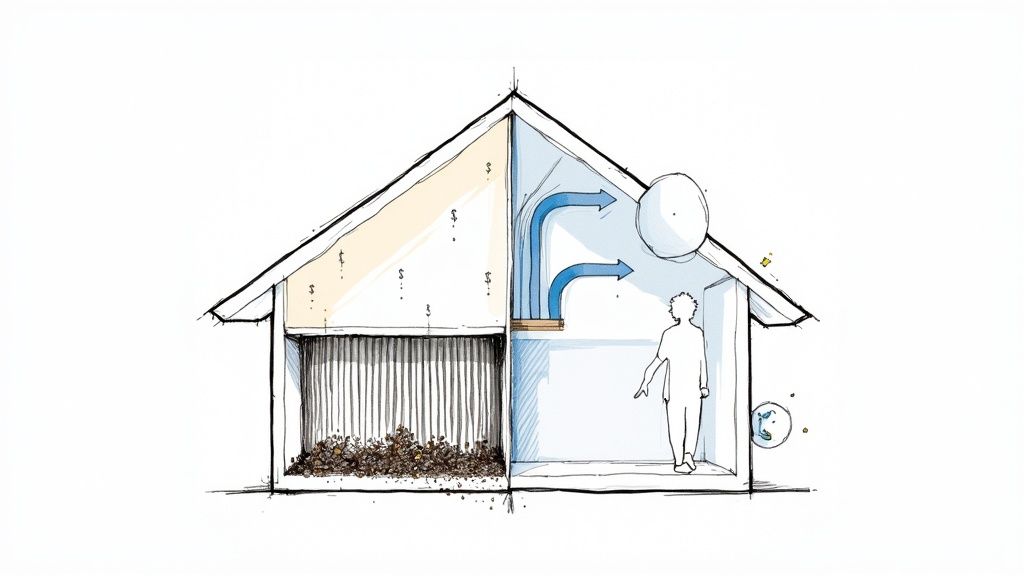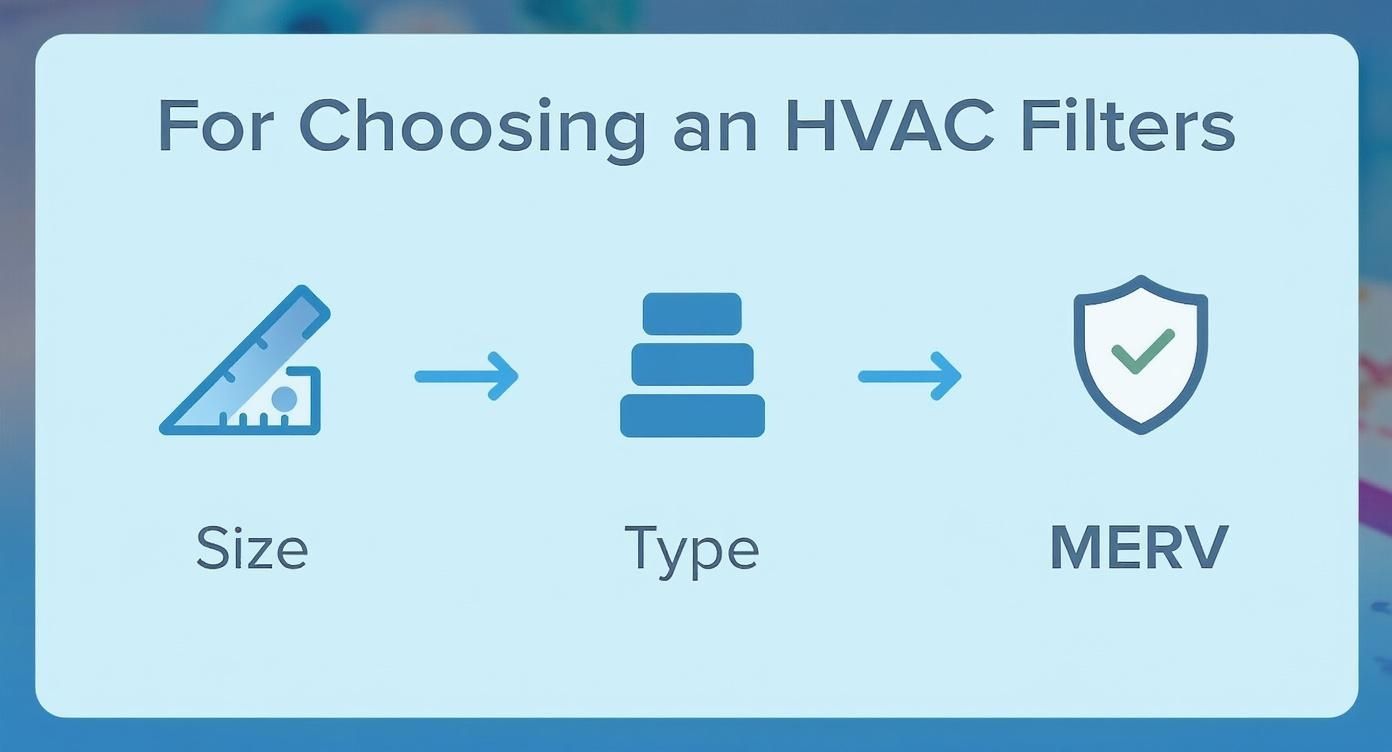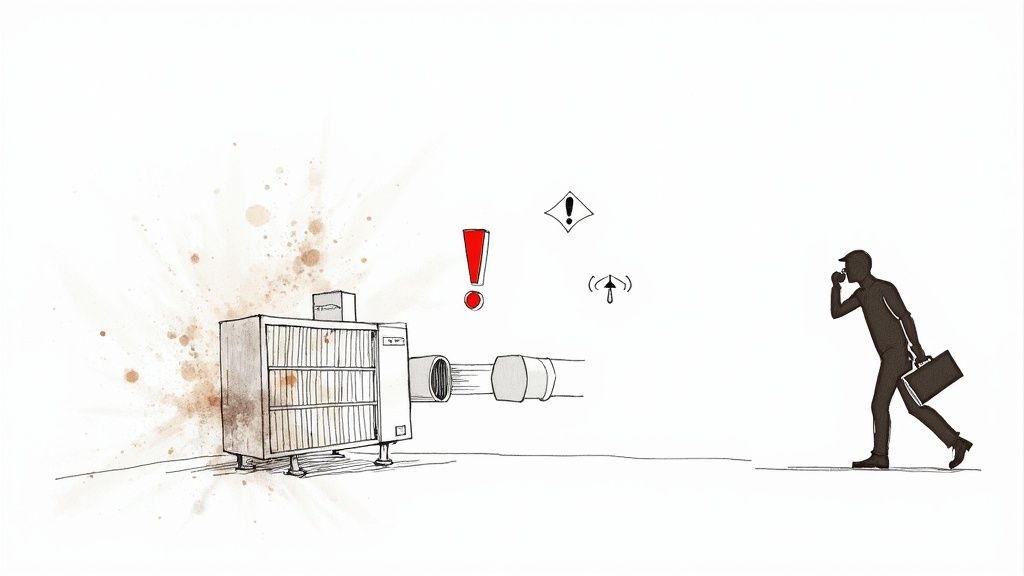Swapping out your HVAC air filter is one of those simple DIY tasks that takes maybe ten minutes but pays you back big time. The whole process is pretty straightforward: kill the power to your system, find the filter slot, slide the old one out, and pop the new one in. Just make sure the little airflow arrow on the new filter is pointing the right way.
That’s it. And honestly, it’s one of the best things you can do to keep your HVAC system healthy and happy. At Top Tech Mechanical, we want to empower homeowners in communities like Kennesaw, Marietta, and Woodstock with the knowledge to handle this simple but crucial task.
Why Changing Your HVAC Filter Is a Homeowner Win

Think of your air filter as the lungs of your home. Its job is to grab all the dust, pollen, pet dander, and other junk floating around before it gets into your house or, even worse, clogs up your expensive equipment. Once that filter gets dirty, it’s like trying to breathe through a straw—your whole system has to work way harder just to pull air through.
That extra strain is a killer. For homeowners here in the Atlanta area, dealing with everything from the heavy pollen in Roswell to the humid summers in Acworth, a clean filter is your first line of defense for staying comfortable and efficient.
The Tangible Benefits of a Clean Filter
It’s easy to forget about this simple task, but ignoring it can cause some surprisingly big headaches. On the flip side, staying on top of your filter changes brings some real-world advantages that you'll notice in your wallet, your family's health, and the lifespan of your unit.
Here’s what you really get:
- Lower Energy Bills: When air flows freely, your system doesn't have to overwork itself. That efficiency boost shows up directly on your monthly power bill.
- Better Indoor Air Quality: A fresh filter is a master at trapping allergens and pollutants. Swapping it out regularly means the air your family breathes is just plain cleaner.
- Longer System Lifespan: Less strain on your HVAC system means less wear and tear on all the important parts. This helps you dodge expensive AC repairs and get more years out of your investment.
A dirty, clogged filter is one of the top reasons we see HVAC systems fail. It chokes off the airflow, which can make the furnace overheat in the winter or cause the evaporator coil to freeze solid in the summer. Both can lead to some seriously expensive damage.
The financial hit is no joke, either. A clogged filter can force your system to use up to 15% more energy. You end up paying more for less comfort, which is a deal nobody wants. If you're interested in the details, you can learn more about the market dynamics of air filters and their impact.
Choosing the Right Air Filter for Your Home
Walking down the HVAC aisle at a hardware store can feel a little overwhelming. You’re hit with a wall of different brands, sizes, and ratings. It’s tempting to just grab whatever looks right, but the wrong filter can do more harm than good.
The first step is always the easiest: find the size. It’s printed right on the frame of your current filter—a series of numbers like 16x25x1. That’s your golden ticket. Getting the size right ensures a snug fit, which stops unfiltered air from sneaking around the edges and getting into your system.
Decoding MERV Ratings
Once you know the size, it’s all about performance. Every filter has a MERV rating, which stands for Minimum Efficiency Reporting Value. Think of it as a report card from 1 to 20 that tells you how well the filter captures airborne gunk. A higher number means it can trap smaller particles, giving you cleaner air.
For most homes, from Canton to Sandy Plains, you don't need to max out the MERV rating. The trick is to find the sweet spot between clean air and healthy airflow. A filter that’s too restrictive can make your HVAC system work way too hard.
Here’s a quick guide to help you choose what’s right for your home.
A Quick Guide to Common HVAC Air Filter Types
Compare the most popular air filter types to find the best fit for your home's needs and budget.
| Filter Type | Typical MERV Rating | Best For | Replacement Frequency |
|---|---|---|---|
| Fiberglass | MERV 1-4 | Basic protection, capturing large particles like dust and lint. | Every 30 days |
| Pleated | MERV 8-13 | Capturing smaller particles like pollen, pet dander, and mold spores. Great for most homes. | Every 60-90 days |
| High-Efficiency | MERV 14+ | Homes with severe allergies, asthma, or other respiratory issues. | Every 6-12 months |
Pleated filters in the MERV 8-13 range are the go-to for most families. They do a fantastic job catching common irritants like pollen and pet dander without choking your system’s airflow. They hit that perfect balance of performance and price. High-efficiency filters are great, but they come with a big catch.
A high-MERV filter is a powerhouse for air quality, but it can also restrict airflow and strain your HVAC unit. Before you upgrade, check your system's manual to make sure it can handle the extra work. When in doubt, it never hurts to ask a pro.
If you’re serious about top-tier indoor air quality, a good filter is just the starting point. For a more complete solution, you can explore our guide on the best whole-house air purifiers to see how different systems work together.
Ultimately, the best filter is one that matches your family’s health needs and your HVAC system’s capabilities.
The Simple Steps to Replace Your HVAC Filter
So, you're ready to tackle this yourself? Great. Learning how to change an HVAC air filter is one of the easiest and most impactful pieces of home maintenance you can do. With the right filter in hand, you're just a few minutes away from cleaner air and a more efficient system.
Before you touch a thing, though, let's talk safety. First things first, head to your thermostat and switch the entire system off. Some furnaces have a separate power switch on or near the unit itself—kind of like a light switch. Flip that off, too. This simple step ensures the unit doesn't unexpectedly kick on while your hands are in there.
Finding and Accessing the Filter
Alright, now for the scavenger hunt. You need to find where your filter lives. Its location can vary depending on your system, but there are two spots that are the most common.
- In a Return Air Vent: Many homes, especially around Roswell and Woodstock, hide the filter right behind a large grille on a wall or ceiling. You'll usually see simple latches or a couple of screws holding the cover in place.
- Near the Air Handler/Furnace: Your filter might also be tucked away in a metal compartment, sandwiched between the main return duct and the furnace unit. Look for a small access door that slides or pops right off.
Once you’ve found it, open the cover. You should see the edge of the old filter peeking out. Take a quick mental note of how it's sitting in there before you pull it out.
Pro Tip: Grab a trash bag before you slide the old filter out. Trust me, it’s going to be full of dust, pet hair, and who knows what else. Having a bag ready keeps that mess from getting all over your floor and right back into the air you're trying to clean.
This infographic breaks down the key decisions you'll make: figuring out the right size, picking a filter type, and choosing the MERV rating that fits your home's needs.

Think of this as your cheat sheet for the selection process. It helps you match the filter to both your system’s technical needs and what you want for your family’s air quality.
Making the Swap
Now for the main event. Carefully slide that old, dirty filter out of its slot. Before you toss it, do one last check of the size printed on its cardboard frame to make sure it's a perfect match for your new one.
Take a close look at your new filter. See that arrow printed on the side? That arrow shows the correct direction for airflow, and getting this right is critical. The arrow must always point towards the furnace or air handler and away from the duct it's pulling air from.
Slide the new filter into the empty slot, making sure the airflow arrow is pointing the right way. It should fit in there snugly, but you shouldn't have to force it.
Last step: pop the access panel back on or close up the grille. Now you can head back to your thermostat and turn the system back on. And here’s one final tip from the field: grab a Sharpie and write today's date on the new filter's frame. It’s a simple trick that makes it impossible to forget when you last changed it, keeping your HVAC maintenance right on schedule.
Pro Tips for Better Air Quality and Efficiency

Knowing how to swap out an air filter is a great start, but a few insider tricks can really take your home’s comfort and your system’s performance to the next level. That old "change it every 90 days" advice? Think of it more as a loose suggestion.
The truth is, your real schedule depends entirely on your home and lifestyle. If you live in a high-pollen area like Cumming or Johns Creek, you might need a fresh filter every month during the spring. Got pets? All that fur and dander means your filter is working overtime and will clog up much faster.
The best approach is to simply check your filter every 30 days and see how it looks.
Tailoring Your Schedule to Your Home
Your own eyes are the best tool you have. Just hold the filter up to a light source. If you can’t see the light shining through, it’s time for a change, no matter what the calendar says.
This little habit does more than just tell you when to buy a new filter—it can also be an early warning sign. If you find your filters are getting filthy after just a few weeks, it might be a clue that your system is pulling in extra dust from leaky ductwork or other air gaps in your home.
A consistently dirty filter is a red flag. It often means your system is fighting against air leaks somewhere, which is a major source of high energy bills and poor performance.
For families dealing with allergies or asthma, upgrading to a filter with a higher MERV rating can be a game-changer. These filters are designed to capture more of the tiny irritants floating around, but you have to find the right balance for your system. The most powerful ones, known as HEPA filters, can trap at least 99.97% of airborne particles, which is why they’re the standard in hospitals and other sensitive environments.
Of course, a clean filter is just one piece of the puzzle. To keep your entire system running smoothly all year, it’s smart to follow a complete guide like the ultimate HVAC preventative maintenance checklist.
Regular filter changes are a cornerstone of our recommended HVAC preventive maintenance checklist, and staying on top of it is the best way to avoid bigger, more expensive problems down the road.
When a Filter Change Is Not Enough

Knowing how to swap out your HVAC filter is a great skill for any homeowner, but it's important to remember it’s not a magic bullet for every heating and cooling issue. Sometimes, a dirty filter is just a symptom of a bigger problem that needs a professional’s touch.
For instance, if you slide in a fresh filter and it’s already caked with grime in just a week or two, that’s a huge red flag. This usually points to leaky ductwork that’s sucking in dusty air from your attic or crawlspace. Likewise, if your system still can’t keep up on a hot Acworth day or a chilly Dunwoody evening, the filter probably isn't the root cause.
Warning Signs to Watch For
After you change the filter, pay close attention to how your system behaves. There are a few tell-tale signs that mean it's time to put the tools away and call for backup.
- Strange Noises: If you suddenly hear clanking, grinding, or squealing, you could be dealing with a failing motor or a loose part.
- Weak Airflow: Is the air barely trickling from your vents even with a clean filter? This often signals a blockage in the ducts or a problem with the blower fan.
- Persistent Odors: Lingering musty or burning smells are serious. They can point to anything from mold growth deep inside the unit to a dangerous electrical issue.
Symptoms like these are well beyond a simple filter replacement. Trying to diagnose them yourself can be risky and often leads to more expensive damage down the road. A professional technician can pinpoint the real problem safely and get it fixed right.
These issues often tie back to your home's overall indoor air quality. If you're worried about what you and your family are breathing, professional air quality testing services can give you clear answers and some much-needed peace of mind.
A Few Common Questions We Get About HVAC Filters
Even with the basics down, a few questions always seem to pop up. We hear the same things from homeowners all the time, so let's clear up those small uncertainties with some quick, straightforward answers.
One of the most common worries is putting the filter in backward. If you slide it in and realize the airflow arrow is pointing the wrong way, don't sweat it. Just turn the system off, pull the filter out, and flip it around.
Running it backward for a little while won't cause your system to explode, but it does make the filter way less effective. Over time, it can definitely put extra strain on your HVAC unit.
How Often to Change It and Can You Reuse It?
Another question we hear a lot is about cleaning and reusing filters. While there are some special washable models out there, the vast majority of the pleated and fiberglass filters you see are disposable. Trying to wash a disposable filter just damages the material, making it useless for trapping dust and sometimes even blocking airflow more than before. When it's disposable, replacing it is always the right call.
So, how often should you really be swapping it out? That "every 90 days" rule is a decent starting point, but it’s definitely not one-size-fits-all. What’s going on inside your home is what really matters.
- Got pets? Plan on every 30-60 days. Pet dander and hair are filter-clogging machines.
- Allergies or asthma in the family? Stick to every 30-45 days to keep the air as clean as possible.
- Average home, no pets? Every 90 days is usually a safe bet.
- Vacation home or just one person living there? You can probably stretch it to every 6-12 months.
Your best bet is to just pull the filter out and look at it once a month. Hold it up to a light. If it looks dark and clogged, it's time for a new one, no matter what the calendar says.
For a deeper dive, learning more about your furnace filter replacement frequency can help you build a schedule that’s perfectly matched to your home.
Finally, people often wonder if a more expensive filter is automatically the better choice. Not always. A pricey, high-MERV filter will capture more tiny particles, but it can also restrict airflow too much for an older system, making it work way too hard. The "best" filter is one that gives you the clean air your family needs without overworking your HVAC unit.
If you've done all this and your system still isn't running right, it might be time to bring in the pros. For reliable HVAC service in Kennesaw, Marietta, or anywhere in our North Atlanta service area, the team at Top Tech Mechanical is here to help. We are experts in everything from routine AC and Heating Maintenance to complex Commercial Rooftop Replacement. Whether it's a simple fix or you need a major installation, our licensed and insured technicians have got your back. Contact us today to schedule your service!
